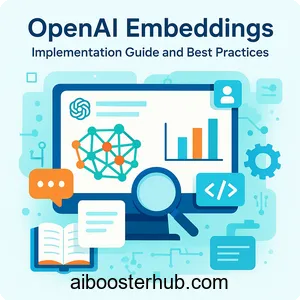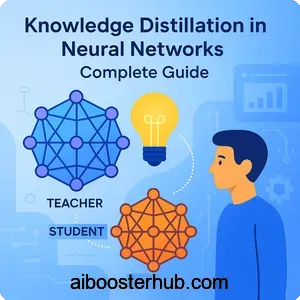OpenAI Embeddings: Implementation Guide and Best Practices
Embeddings have revolutionized how we process and understand text in artificial intelligence applications. OpenAI embeddings, in particular, have become the gold standard for converting text into meaningful numerical representations that capture semantic relationships. Whether you’re building a semantic search engine, a recommendation system, or a chatbot with contextual memory, understanding how to effectively implement openai embedding models is crucial for modern AI development.

This comprehensive guide will walk you through everything you need to know about openai embeddings api, from fundamental concepts to advanced implementation strategies. We’ll explore practical examples using Python, dive into the mathematics behind embedding models, and share best practices that will help you build robust AI applications.
Content
Toggle1. Understanding OpenAI embeddings and their significance
What are embeddings?
At their core, embeddings are dense vector representations of text that capture semantic meaning in a high-dimensional space. Unlike traditional methods that treat words as discrete symbols, embedding models transform text into continuous vectors where similar concepts cluster together. This mathematical representation enables machines to understand that “king” is to “queen” as “man” is to “woman” through vector arithmetic.
The power of openai embedding lies in their ability to encode nuanced semantic relationships. When you convert the phrase “artificial intelligence” into an embedding vector, the resulting representation contains information about technology, computing, automation, and countless other related concepts. These vectors typically range from hundreds to thousands of dimensions, with each dimension capturing different aspects of meaning.
The mathematical foundation
Embeddings operate in a vector space where semantic similarity translates to geometric proximity. The similarity between two embeddings is typically measured using cosine similarity:
$$ \text{similarity}(A, B) = \frac{A \cdot B}{|A| |B|} = \frac{\sum_{i=1}^{n} A_i B_i}{\sqrt{\sum_{i=1}^{n} A_i^2} \sqrt{\sum_{i=1}^{n} B_i^2}} $$
This formula produces a value between -1 and 1, where 1 indicates identical semantic meaning, 0 indicates no relationship, and -1 indicates opposite meanings. In practice, most meaningful text similarities fall between 0.5 and 0.95.
Why OpenAI embeddings?
OpenAI embeddings stand out for several reasons. The text-embedding-ada-002 model, for instance, offers an exceptional balance between performance and cost-efficiency. It produces 1536-dimensional vectors that capture rich semantic information while remaining computationally manageable. The model has been trained on diverse internet text, enabling it to understand context across multiple domains and languages.
Unlike simpler embedding techniques like Word2Vec or GloVe, openai embedding models leverage transformer architecture, allowing them to capture contextual meaning. The word “bank” receives different embeddings depending on whether you’re discussing financial institutions or river banks, showcasing the context-awareness that makes these models so powerful.
2. Setting up the OpenAI embeddings API
Installation and authentication
Getting started with the openai embeddings api requires minimal setup. First, install the OpenAI Python library:
pip install openai
Next, authenticate using your API key. Always store sensitive credentials as environment variables rather than hardcoding them:
import openai
import os
# Set your API key
openai.api_key = os.getenv("OPENAI_API_KEY")
# Alternative: using the newer client interface
from openai import OpenAI
client = OpenAI(api_key=os.getenv("OPENAI_API_KEY"))
Creating your first embedding
Let’s create a simple embedding to understand the basic workflow:
from openai import OpenAI
client = OpenAI()
def get_embedding(text, model="text-embedding-ada-002"):
"""Generate an embedding for the given text."""
text = text.replace("\n", " ")
response = client.embeddings.create(
input=text,
model=model
)
return response.data[0].embedding
# Example usage
text = "Machine learning is transforming the world"
embedding = get_embedding(text)
print(f"Embedding dimension: {len(embedding)}")
print(f"First 5 values: {embedding[:5]}")
This code will output a 1536-dimensional vector. The first few values might look like: [0.0023, -0.0152, 0.0089, -0.0034, 0.0198]. Each number represents the text’s position along a particular semantic dimension.
Batch processing for efficiency
When working with multiple texts, batch processing significantly improves efficiency and reduces API calls:
def get_embeddings_batch(texts, model="text-embedding-ada-002"):
"""Generate embeddings for multiple texts in a single API call."""
# Clean texts
texts = [text.replace("\n", " ") for text in texts]
response = client.embeddings.create(
input=texts,
model=model
)
return [data.embedding for data in response.data]
# Process multiple texts at once
documents = [
"Natural language processing enables computers to understand human language",
"Deep learning models require large amounts of training data",
"Computer vision allows machines to interpret visual information"
]
embeddings = get_embeddings_batch(documents)
print(f"Generated {len(embeddings)} embeddings")
The openai embedding api supports up to 2048 input texts per request, making batch processing both practical and cost-effective.
3. Implementing semantic search with embedding models
Building a semantic search engine
Semantic search represents one of the most powerful applications of openai embeddings. Unlike keyword-based search, semantic search understands intent and context. Let’s build a complete semantic search system:
import numpy as np
from openai import OpenAI
client = OpenAI()
class SemanticSearchEngine:
def __init__(self, documents):
"""Initialize search engine with documents."""
self.documents = documents
self.embeddings = self._generate_embeddings()
def _generate_embeddings(self):
"""Generate embeddings for all documents."""
print("Generating embeddings...")
response = client.embeddings.create(
input=self.documents,
model="text-embedding-ada-002"
)
return np.array([data.embedding for data in response.data])
def _cosine_similarity(self, a, b):
"""Calculate cosine similarity between two vectors."""
return np.dot(a, b) / (np.linalg.norm(a) * np.linalg.norm(b))
def search(self, query, top_k=3):
"""Search for most relevant documents."""
# Generate query embedding
query_response = client.embeddings.create(
input=query,
model="text-embedding-ada-002"
)
query_embedding = np.array(query_response.data[0].embedding)
# Calculate similarities
similarities = []
for idx, doc_embedding in enumerate(self.embeddings):
similarity = self._cosine_similarity(query_embedding, doc_embedding)
similarities.append((idx, similarity))
# Sort and return top results
similarities.sort(key=lambda x: x[1], reverse=True)
results = []
for idx, score in similarities[:top_k]:
results.append({
'document': self.documents[idx],
'score': score
})
return results
# Example usage
knowledge_base = [
"Python is a high-level programming language known for its simplicity",
"Machine learning algorithms learn patterns from data",
"Neural networks are inspired by biological brain structures",
"Data preprocessing is crucial for model performance",
"Transfer learning leverages pre-trained models for new tasks"
]
search_engine = SemanticSearchEngine(knowledge_base)
results = search_engine.search("How do computers learn from examples?")
for i, result in enumerate(results, 1):
print(f"\n{i}. Score: {result['score']:.4f}")
print(f" Document: {result['document']}")
This implementation will correctly identify that “How do computers learn from examples?” is most semantically similar to “Machine learning algorithms learn patterns from data,” even though they share few keywords.
Advanced similarity metrics
While cosine similarity is standard, understanding alternative metrics can improve your llm embedding applications:
The Euclidean distance measures absolute distance in vector space:
$$ d(A, B) = \sqrt{\sum_{i=1}^{n} (A_i – B_i)^2} $$
For normalized embeddings (which OpenAI provides), cosine similarity and Euclidean distance are mathematically related: \( d(A, B) = \sqrt{2(1 – \text{similarity}(A, B))} \).
Handling large-scale search
When dealing with thousands or millions of documents, brute-force similarity computation becomes impractical. Vector databases provide efficient approximate nearest neighbor search:
# Example using FAISS for efficient similarity search
import faiss
class ScalableSearchEngine:
def __init__(self, documents, embedding_dim=1536):
self.documents = documents
self.embedding_dim = embedding_dim
self.index = faiss.IndexFlatIP(embedding_dim) # Inner product (for normalized vectors)
self._build_index()
def _build_index(self):
"""Build FAISS index from embeddings."""
embeddings = self._get_all_embeddings()
# Normalize embeddings for cosine similarity
faiss.normalize_L2(embeddings)
# Add to index
self.index.add(embeddings)
def _get_all_embeddings(self):
"""Generate embeddings for all documents."""
response = client.embeddings.create(
input=self.documents,
model="text-embedding-ada-002"
)
embeddings = np.array([data.embedding for data in response.data], dtype='float32')
return embeddings
def search(self, query, top_k=5):
"""Fast semantic search using FAISS."""
# Get query embedding
query_response = client.embeddings.create(
input=query,
model="text-embedding-ada-002"
)
query_embedding = np.array([query_response.data[0].embedding], dtype='float32')
# Normalize
faiss.normalize_L2(query_embedding)
# Search
scores, indices = self.index.search(query_embedding, top_k)
results = []
for idx, score in zip(indices[0], scores[0]):
results.append({
'document': self.documents[idx],
'score': float(score)
})
return results
This approach scales to millions of documents with sub-millisecond query times.
4. Working with Azure OpenAI embeddings
Understanding Azure OpenAI service
Azure openai embeddings provide an enterprise-grade alternative to the standard OpenAI API. Organizations often prefer Azure for compliance, data residency, and integration with existing Microsoft infrastructure. The embedding models remain identical, but deployment and authentication differ.
Setting up Azure OpenAI embeddings
Configuration requires additional parameters:
from openai import AzureOpenAI
# Initialize Azure OpenAI client
azure_client = AzureOpenAI(
api_key=os.getenv("AZURE_OPENAI_API_KEY"),
api_version="2023-05-15",
azure_endpoint=os.getenv("AZURE_OPENAI_ENDPOINT")
)
def get_azure_embedding(text, deployment_name="text-embedding-ada-002"):
"""Generate embedding using Azure OpenAI."""
response = azure_client.embeddings.create(
input=text,
model=deployment_name # This is your deployment name in Azure
)
return response.data[0].embedding
# Example usage
text = "Azure provides enterprise AI capabilities"
embedding = get_azure_embedding(text)
The key difference is that Azure uses deployment names rather than model names, allowing you to control which specific model version your application uses.
Hybrid approach: Switching between providers
For maximum flexibility, create an abstraction layer:
class EmbeddingProvider:
def __init__(self, provider="openai"):
self.provider = provider
if provider == "openai":
self.client = OpenAI()
self.model_name = "text-embedding-ada-002"
elif provider == "azure":
self.client = AzureOpenAI(
api_key=os.getenv("AZURE_OPENAI_API_KEY"),
api_version="2023-05-15",
azure_endpoint=os.getenv("AZURE_OPENAI_ENDPOINT")
)
self.model_name = os.getenv("AZURE_DEPLOYMENT_NAME")
def get_embedding(self, text):
"""Get embedding regardless of provider."""
response = self.client.embeddings.create(
input=text,
model=self.model_name
)
return response.data[0].embedding
# Use the same code for both providers
provider = EmbeddingProvider(provider="azure") # or "openai"
embedding = provider.get_embedding("Flexible embedding generation")
5. Best practices for production applications
Error handling and retry logic
Production systems must handle API failures gracefully:
import time
from openai import OpenAI, RateLimitError, APIError
client = OpenAI()
def get_embedding_with_retry(text, max_retries=3, model="text-embedding-ada-002"):
"""Generate embedding with exponential backoff retry."""
for attempt in range(max_retries):
try:
response = client.embeddings.create(
input=text,
model=model
)
return response.data[0].embedding
except RateLimitError:
if attempt == max_retries - 1:
raise
wait_time = (2 ** attempt) + 1
print(f"Rate limit hit. Waiting {wait_time} seconds...")
time.sleep(wait_time)
except APIError as e:
if attempt == max_retries - 1:
raise
print(f"API error: {e}. Retrying...")
time.sleep(2)
except Exception as e:
print(f"Unexpected error: {e}")
raise
return None
Caching strategies
Embeddings are deterministic—identical input always produces identical output. Implement caching to reduce costs and latency:
import hashlib
import json
import os
class EmbeddingCache:
def __init__(self, cache_dir="embedding_cache"):
self.cache_dir = cache_dir
os.makedirs(cache_dir, exist_ok=True)
def _get_cache_key(self, text, model):
"""Generate cache key from text and model."""
content = f"{model}:{text}"
return hashlib.md5(content.encode()).hexdigest()
def get(self, text, model):
"""Retrieve embedding from cache."""
cache_key = self._get_cache_key(text, model)
cache_path = os.path.join(self.cache_dir, f"{cache_key}.json")
if os.path.exists(cache_path):
with open(cache_path, 'r') as f:
return json.load(f)
return None
def set(self, text, model, embedding):
"""Store embedding in cache."""
cache_key = self._get_cache_key(text, model)
cache_path = os.path.join(self.cache_dir, f"{cache_key}.json")
with open(cache_path, 'w') as f:
json.dump(embedding, f)
def get_or_generate(self, text, model="text-embedding-ada-002"):
"""Get from cache or generate new embedding."""
cached = self.get(text, model)
if cached:
return cached
# Generate new embedding
response = client.embeddings.create(input=text, model=model)
embedding = response.data[0].embedding
# Cache it
self.set(text, model, embedding)
return embedding
# Usage
cache = EmbeddingCache()
embedding = cache.get_or_generate("This will be cached")
Token management and cost optimization
OpenAI charges based on tokens processed. Optimize by preprocessing text:
import tiktoken
def estimate_tokens(text, model="text-embedding-ada-002"):
"""Estimate token count for text."""
encoding = tiktoken.encoding_for_model(model)
return len(encoding.encode(text))
def truncate_text(text, max_tokens=8191, model="text-embedding-ada-002"):
"""Truncate text to fit within token limit."""
encoding = tiktoken.encoding_for_model(model)
tokens = encoding.encode(text)
if len(tokens) <= max_tokens:
return text
# Truncate and decode
truncated_tokens = tokens[:max_tokens]
return encoding.decode(truncated_tokens)
# Example usage
long_text = "..." * 10000 # Very long text
safe_text = truncate_text(long_text)
embedding = get_embedding(safe_text)
Monitoring and observability
Track embedding generation for debugging and optimization:
import time
from datetime import datetime
class MonitoredEmbeddingClient:
def __init__(self):
self.client = OpenAI()
self.metrics = {
'total_requests': 0,
'total_tokens': 0,
'total_time': 0,
'errors': 0
}
def get_embedding(self, text, model="text-embedding-ada-002"):
"""Generate embedding with monitoring."""
start_time = time.time()
try:
response = self.client.embeddings.create(
input=text,
model=model
)
# Update metrics
self.metrics['total_requests'] += 1
self.metrics['total_tokens'] += response.usage.total_tokens
self.metrics['total_time'] += time.time() - start_time
return response.data[0].embedding
except Exception as e:
self.metrics['errors'] += 1
raise
def get_stats(self):
"""Return performance statistics."""
avg_time = (self.metrics['total_time'] / self.metrics['total_requests']
if self.metrics['total_requests'] > 0 else 0)
return {
'total_requests': self.metrics['total_requests'],
'total_tokens': self.metrics['total_tokens'],
'average_latency': f"{avg_time:.3f}s",
'error_rate': f"{(self.metrics['errors'] / max(self.metrics['total_requests'], 1)) * 100:.2f}%"
}
# Usage
monitored_client = MonitoredEmbeddingClient()
embedding = monitored_client.get_embedding("Monitor this request")
print(monitored_client.get_stats())
6. Advanced use cases and applications
Building recommendation systems
Embeddings excel at content-based recommendations:
class RecommendationEngine:
def __init__(self, items, item_descriptions):
"""
Initialize recommendation engine.
Args:
items: List of item identifiers
item_descriptions: List of text descriptions for each item
"""
self.items = items
self.descriptions = item_descriptions
self.embeddings = self._generate_embeddings()
def _generate_embeddings(self):
"""Generate embeddings for all items."""
response = client.embeddings.create(
input=self.descriptions,
model="text-embedding-ada-002"
)
return np.array([data.embedding for data in response.data])
def recommend(self, user_preferences, top_k=5):
"""
Recommend items based on user preferences.
Args:
user_preferences: Text describing what user likes
top_k: Number of recommendations to return
"""
# Get embedding for user preferences
pref_response = client.embeddings.create(
input=user_preferences,
model="text-embedding-ada-002"
)
pref_embedding = np.array(pref_response.data[0].embedding)
# Calculate similarities
similarities = []
for idx, item_embedding in enumerate(self.embeddings):
similarity = np.dot(pref_embedding, item_embedding) / (
np.linalg.norm(pref_embedding) * np.linalg.norm(item_embedding)
)
similarities.append((self.items[idx], similarity))
# Sort and return top recommendations
similarities.sort(key=lambda x: x[1], reverse=True)
return similarities[:top_k]
# Example: Movie recommendations
movies = ["Movie A", "Movie B", "Movie C", "Movie D"]
descriptions = [
"A thrilling sci-fi adventure with robots and space exploration",
"A heartwarming romantic comedy set in Paris",
"An action-packed superhero film with stunning visual effects",
"A documentary about artificial intelligence and its impact on society"
]
recommender = RecommendationEngine(movies, descriptions)
recommendations = recommender.recommend(
"I love science fiction and technology documentaries",
top_k=3
)
for movie, score in recommendations:
print(f"{movie}: {score:.4f}")
Clustering and categorization
Group similar content automatically using embedding-based clustering:
from sklearn.cluster import KMeans
import matplotlib.pyplot as plt
from sklearn.decomposition import PCA
def cluster_documents(documents, n_clusters=3):
"""Cluster documents based on semantic similarity."""
# Generate embeddings
response = client.embeddings.create(
input=documents,
model="text-embedding-ada-002"
)
embeddings = np.array([data.embedding for data in response.data])
# Perform clustering
kmeans = KMeans(n_clusters=n_clusters, random_state=42)
clusters = kmeans.fit_predict(embeddings)
# Reduce dimensions for visualization
pca = PCA(n_components=2)
embeddings_2d = pca.fit_transform(embeddings)
# Organize results
clustered_docs = {i: [] for i in range(n_clusters)}
for doc, cluster_id in zip(documents, clusters):
clustered_docs[cluster_id].append(doc)
return clustered_docs, embeddings_2d, clusters
# Example: Categorize articles
articles = [
"Latest breakthroughs in quantum computing",
"How to train your dog effectively",
"Machine learning transforming healthcare",
"Best practices for pet nutrition",
"Neural networks achieve human-level performance",
"Understanding cat behavior and psychology"
]
clusters, embeddings_2d, labels = cluster_documents(articles, n_clusters=2)
print("Cluster assignments:")
for cluster_id, docs in clusters.items():
print(f"\nCluster {cluster_id}:")
for doc in docs:
print(f" - {doc}")
Question-answering systems
Combine embeddings with retrieval for intelligent Q&A:
class QASystem:
def __init__(self, knowledge_base):
"""
Initialize QA system with knowledge base.
Args:
knowledge_base: Dict with 'question' and 'answer' keys
"""
self.kb = knowledge_base
self.questions = [item['question'] for item in knowledge_base]
self.answers = [item['answer'] for item in knowledge_base]
self.question_embeddings = self._generate_embeddings()
def _generate_embeddings(self):
"""Generate embeddings for all questions."""
response = client.embeddings.create(
input=self.questions,
model="text-embedding-ada-002"
)
return np.array([data.embedding for data in response.data])
def answer(self, query, threshold=0.7):
"""
Answer user query based on knowledge base.
Args:
query: User's question
threshold: Minimum similarity score to return answer
"""
# Get query embedding
query_response = client.embeddings.create(
input=query,
model="text-embedding-ada-002"
)
query_embedding = np.array(query_response.data[0].embedding)
# Find most similar question
best_match_idx = -1
best_similarity = -1
for idx, q_embedding in enumerate(self.question_embeddings):
similarity = np.dot(query_embedding, q_embedding) / (
np.linalg.norm(query_embedding) * np.linalg.norm(q_embedding)
)
if similarity > best_similarity:
best_similarity = similarity
best_match_idx = idx
# Return answer if confidence is high enough
if best_similarity >= threshold:
return {
'answer': self.answers[best_match_idx],
'confidence': best_similarity,
'matched_question': self.questions[best_match_idx]
}
else:
return {
'answer': "I don't have enough information to answer that question.",
'confidence': best_similarity,
'matched_question': None
}
# Example usage
kb = [
{
'question': "What is machine learning?",
'answer': "Machine learning is a subset of AI that enables systems to learn from data."
},
{
'question': "How do neural networks work?",
'answer': "Neural networks process information through layers of interconnected nodes."
},
{
'question': "What is deep learning?",
'answer': "Deep learning uses multi-layer neural networks to learn hierarchical representations."
}
]
qa_system = QASystem(kb)
result = qa_system.answer("Can you explain what ML is?")
print(f"Answer: {result['answer']}")
print(f"Confidence: {result['confidence']:.4f}")
Multilingual applications
The text-embedding-ada-002 model supports multiple languages, enabling cross-lingual search:
def cross_lingual_search(query, documents, document_languages):
"""
Search across documents in multiple languages.
Args:
query: Search query in any language
documents: List of documents in various languages
document_languages: List of language codes
"""
# Generate embeddings (works across languages)
all_texts = [query] + documents
response = client.embeddings.create(
input=all_texts,
model="text-embedding-ada-002"
)
embeddings = np.array([data.embedding for data in response.data])
query_embedding = embeddings[0]
doc_embeddings = embeddings[1:]
# Calculate similarities
results = []
for idx, (doc, lang, emb) in enumerate(zip(documents, document_languages, doc_embeddings)):
similarity = np.dot(query_embedding, emb) / (
np.linalg.norm(query_embedding) * np.linalg.norm(emb)
)
results.append({
'document': doc,
'language': lang,
'score': similarity
})
results.sort(key=lambda x: x['score'], reverse=True)
return results
# Example: Search in multiple languages
docs = [
"Machine learning enables computers to learn from data",
"L'apprentissage automatique permet aux ordinateurs d'apprendre",
"El aprendizaje automático permite que las computadoras aprendan"
]
languages = ['en', 'fr', 'es']
results = cross_lingual_search("AI and data science", docs, languages)
for r in results:
print(f"[{r['language']}] Score: {r['score']:.4f} - {r['document'][:50]}...")
7. Conclusion
OpenAI embeddings represent a transformative technology for natural language understanding and semantic analysis. Throughout this guide, we’ve explored how to implement the openai embeddings api effectively, from basic text vectorization to sophisticated applications like semantic search, recommendation systems, and multilingual content discovery. The versatility of embedding models makes them indispensable for modern AI applications, whether you’re building chatbots, knowledge management systems, or content recommendation engines.
As you implement these techniques in your projects, remember that success lies in understanding both the capabilities and limitations of openai embedding models. Focus on proper error handling, implement caching strategies for cost optimization, and continuously monitor your system’s performance. Whether you’re using the standard OpenAI API or azure openai embeddings, the principles and best practices outlined here will help you build robust, scalable AI applications that truly understand the semantic meaning of text.









